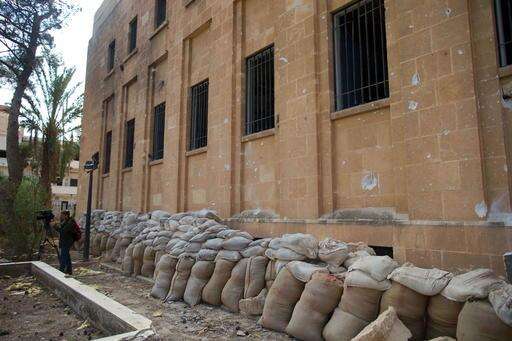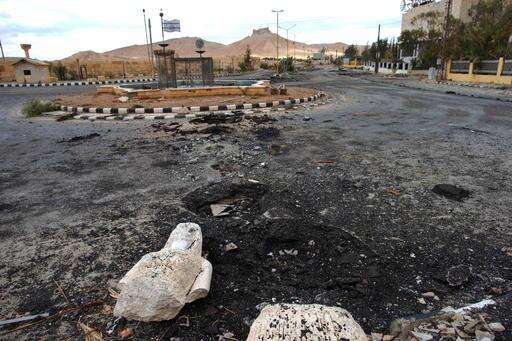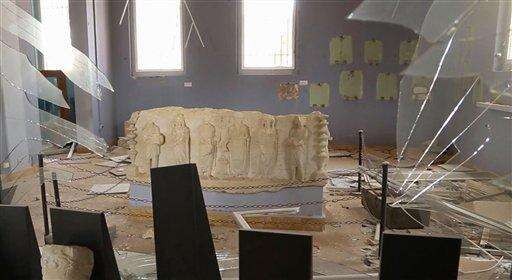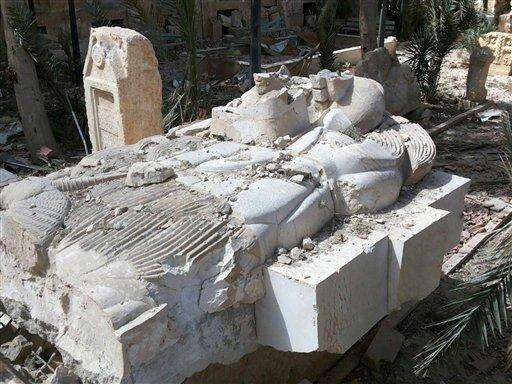In this Thursday, April 14, 2016 photo, the Lion of Al-Lat statue outside the museum with some broken pieces lying next to it at the entrance of the museum in the town of Palmyra in the central Homs province, Syria. Polish experts back from assessing damage at the museum in the Syrian town of Palmyra offer grim new details about the extent of the destruction caused by the Islamic State group. The museum was trashed and some of its best-known artifacts and statues were smashed by the extremists during the 10 months they controlled the town, before being driven out last month. (AP Photo/Hassan Ammar)
The Associated Press
DAMASCUS, Syria (AP) - The first foreign experts who visited the museum in Palmyra after it was taken over from Islamic State militants said they spent a week collecting fragments of priceless broken sculptures from the museum grounds and preparing them for transportation to Damascus in a rescue mission they hope will help salvage most of its contents.
Back in the Syrian capital Saturday, they offered grim new details about the extent of the destruction caused by the extremists during their 10-month stay in the ancient town.
The museum was trashed and some of its best-known artifacts and statues were smashed by the militants, who cut off the heads and hands of statues and demolished others before being driven out last month.
Bartosz Markowski, from the Polish Archaeological Center at the University of Warsaw, told The Associated Press that most of the 200 objects which were exhibited on the ground floor of the Palmyra museum were destroyed, many of them apparently with hard tools like hammers. Many artifacts have been stolen, he added, thought it was not possible to know how many.
He and his colleagues were the first specialists to visit Palmyra after it was taken over by the Syrian army, and spent a week working and assessing the damage.
"We collected everything we could. The fragments were spread around the whole museum among broken glass and furniture ... It is a catastrophe," he said, speaking to the AP in the garden of the National Museum in Damascus.
During their rule of Palmyra, the extremists demolished some of the most famous Roman-era monuments that stand just outside the town, including two large temples dating back more than 1,800 years and a Roman triumphal archway, filming the destruction themselves for the world to see. The sprawling outdoor site, a UNESCO world heritage site, as well as the museum were among Syria's main tourist attractions before the civil war.
Among the best-known statues destroyed was the famous Lion of Allat, a 2000-year-old statue which previously greeted visitors and tourists outside the Palmyra museum. The statue, which used to adorn the temple of Allat, a pre-Islamic goddess in Palmyra, was defaced by IS militants and knocked over by bulldozers.
On a visit to Palmyra on Thursday, The Associated Press saw the statue lying outside the museum building with its face cut and some of its broken pieces lying next to it.
"Fortunately we collected most of the fragments and I hope it can be reconstructed very soon," said Markowski, who in 2005 took part in a Polish archaeological mission that did renovation work on the statue.
His colleague, Robert Zukowski, said the limestone lion statue should be the first thing restored and "it should stay in Palmyra as a sign of resistance against the barbarians. "
In addition to the damage inflicted by IS, Markowski said the museum building has suffered structural damage due to bombs falling.
"There's broken ceilings, broken walls, roofs, a lot of garbage and fragments of bricks everywhere, and among that there are fragments of sculptures," he said.
He said the restoration will require a massive international effort and years to accomplish.
"I think most of the objects can be restored, but they will never look as they did before," he added.
In this Thursday, April 14, 2016 photo, boxes loaded with pieces of the Palmyra museum rescued artifacts n a truck before moving them to a safe location in the town of Palmyra in the central Homs province, Syria. Polish experts back from assessing damage at the museum in the Syrian town of Palmyra offer grim new details about the extent of the destruction caused by the Islamic State group. The museum was trashed and some of its best-known artifacts and statues were smashed by the extremists during the 10 months they controlled the town, before being driven out last month. (AP Photo/Hassan Ammar)
The Associated Press

In this Thursday, April 14, 2016 photo, sand bags used by ISIS fighters to protect the basement of Palmyra museum are seen as a German cameraman films in the town of Palmyra in the central Homs province, Syria. Polish experts back from assessing damage at the museum in the Syrian town of Palmyra offer grim new details about the extent of the destruction caused by the Islamic State group. The museum was trashed and some of its best-known artifacts and statues were smashed by the extremists during the 10 months they controlled the town, before being driven out last month. (AP Photo/Hassan Ammar)
The Associated Press

In this Thursday, April 14, 2016 photo, the Palmyra citadel is seen in the background as a broken statue is seen on the ground outside the Palmyra museum in the town of Palmyra in the central Homs province, Syria. Polish experts back from assessing damage at the museum in the Syrian town of Palmyra offer grim new details about the extent of the destruction caused by the Islamic State group. The museum was trashed and some of its best-known artifacts and statues were smashed by the extremists during the 10 months they controlled the town, before being driven out last month. (AP Photo/Hassan Ammar)
The Associated Press

In this Thursday, April 14, 2016 photo, a Syrian soldier sets on truck with boxes loaded with pieces of the Palmyra museum rescued artifacts as they moving them to a safe location in the town of Palmyra in the central Homs province, Syria. Polish experts back from assessing damage at the museum in the Syrian town of Palmyra offer grim new details about the extent of the destruction caused by the Islamic State group. The museum was trashed and some of its best-known artifacts and statues were smashed by the extremists during the 10 months they controlled the town, before being driven out last month. (AP Photo/Hassan Ammar)
The Associated Press

In this Thursday, April 14, 2016, boxes loaded with rescued artifacts from the Palmyra museum are seen in a truck before moving them to a safe location in the town of Palmyra in the central Homs province, Syria. Polish experts back from assessing damage at the museum in the Syrian town of Palmyra offer grim new details about the extent of the destruction caused by the Islamic State group. The museum was trashed and some of its best-known artifacts and statues were smashed by the extremists during the 10 months they controlled the town, before being driven out last month. (AP Photo/Hassan Ammar)
The Associated Press

FILE - This photo released on Monday March 28, 2016, by the Syrian official news agency SANA, shows destroyed statues at the damaged Palmyra Museum, in Palmyra city, central Syria. Polish experts back from assessing damage at the museum in the Syrian city of Palmyra offer grim new details about the extent of the destruction caused by the Islamic State group. The museum was trashed and some of its best-known artifacts and statues were smashed by the extremists during the 10 months they controlled the town, before being driven out last month. (SANA via AP, File)
The Associated Press

FILE - This photo released on Sunday March 27, 2016, by the Syrian official news agency SANA, shows a destroyed statue outside the damaged Palmyra Museum, in Palmyra city, central Syria. Polish experts back from assessing damage at the museum in the Syrian city of Palmyra offer grim new details about the extent of the destruction caused by the Islamic State group. The museum was trashed and some of its best-known artifacts and statues were smashed by the extremists during the 10 months they controlled the town, before being driven out last month. (SANA via AP, File)
The Associated Press

FILE - This photo released on Sunday March 27, 2016, by the Syrian official news agency SANA, shows destroyed statues at the damaged Palmyra Museum, in Palmyra city, central Syria. Polish experts back from assessing damage at the museum in the Syrian city of Palmyra offer grim new details about the extent of the destruction caused by the Islamic State group. The museum was trashed and some of its best-known artifacts and statues were smashed by the extremists during the 10 months they controlled the town, before being driven out last month. (SANA via AP, FILE)
The Associated Press